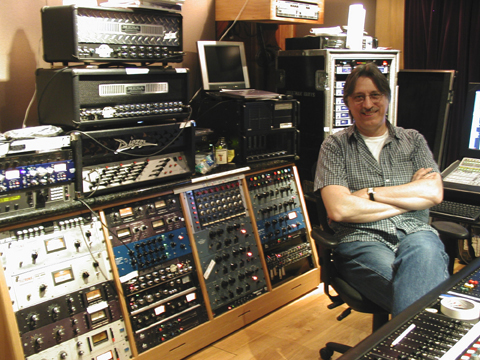UAD-1 Feature: Frank Filipetti and the Digital Road Less Traveled
 |
|
Frank Filipetti with a whole rack full of UA, and some other really nice gear
|
Though widely acknowledged as having helped lead the trend to digital recording, Filipetti was in fact an analog guy until around 1991. “I moved over to digital when the Sony 3348 came out. I wasn’t a fan of the 3324, but the 48-track machine just sounded better.” Even then, like everyone else he was still mixing to analog. Frustrated by the inevitably weak link of multiple A/D/A conversions, he began seeking a digital mixdown format that sounded the way he knew it should. “We started investigating digital mixdown formats in ’93 or ’94, and in ’95 we finally found the Neve Capricorn, which we installed at Right Track. Since then I’ve been primarily recording and mixing on digital consoles.”
“I wish more companies that are emulating classic gear paid attention to what they’re doing at UA. The mind-set over there is right on the money. The hardware and software they’re doing should be a model for the rest of the industry.”
These days Filipetti does much of his recording and mixing on the Euphonix R-1 digital recording environment. “Sonically, it’s as good as or better than analog. I was working on the first KoRn album with (producer) Michael Beinhorn. Michael’s a serious analog guy – he’s even got a 2-inch 8-track analog machine, and the plan was to record the KoRn album in analog. I brought along the R-1 to do an A/B comparison. We spent two days listening to various analog and digital machines, but once he heard it he was totally enamored with the R1, using DB (now Lavry Engineering) converters in front. He’s been recording almost everything that way for the last two years.”
Generally, Filipetti uses the Euphonix for tracking and mixdowns. For editing, manipulating and all work in between, his vehicle of choice is Steinberg’s Nuendo. And he’s been instrumental in helping to forge an alliance between the two companies. “When we started the KoRn project, there were really only two games in town – ProTools or the Euphonix. We couldn’t use ProTools because it didn’t go to 96kHz (it now does), and it didn’t conform to the AES-31 standard (it still doesn’t). We ended up checking out Nuendo because Steinberg was interested in making the cross-compatibility issues work. We put the Euphonix and Steinberg people together, and they’ve ended up working on several projects together, some of which they just showed at NAB.”
Filipetti cites Nuendo’s flexibility and versatility as major defining factors. “A lot of software can’t open multi-bit sessions or support interleaved files, or open more than one project at a time. I mixed a Liza Minelli live show last year, recorded live to ProTools. They recorded two nights of live shows, and each night was one very large file. These were three hour files of 48 tracks. Loading either file took two or three minutes. It was a bit frustrating trying to do cross-edits between the shows, because I’d have to shut down and re-load every time I wanted to change files. We bumped the files into Nuendo and were able to have both sessions open at once, so we could instantly A/B tracks, and cut and paste from one to the other in a matter of seconds.”
Another indispensable component in his arsenal is the UAD-1 card from Universal Audio, which he particularly loves for its classic compressor emulation. “The UAD-1 [suite of plug-ins] are some of the few plugins I have. Generally I find most plug-in emulators to fall way short of the real thing. However, the UAD-1 compressors are quite comparable to the hardware units. One of the issues I generally have with digital compressors is that the people making them are looking for transparency. That’s usually the last thing I’m looking for in a compressor – I want it to have a sonic character. That’s the reason we use this stuff, because it imparts a sound. It’s not just a limiting or level-reducing device; it actually adds a character beyond the function it performs. The people at UA are among the few in this area who saw this early on. I bought two of the (new hardware) 1176’s and two of the LA-2A’s, and they sound very much like the original ones. Of course, every vintage 1176 sounds different; some have characteristics I like, some don’t. But the new ones fall right in the middle, and that’s much better than taking a chance on an old one.”
Filipetti pays high praise to the folks at Universal Audio. “I wish more companies that are emulating classic gear paid attention to what they’re doing at UA. The mind-set over there is right on the money. The hardware and software they’re doing should be a model for the rest of the industry.”
Clearly, Frank Filipetti gives a lot back to the companies whose gear he works with. This kind of involvement and constructive feedback can only help these companies to improve their products, and for that we can all be thankful.